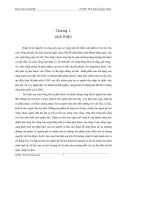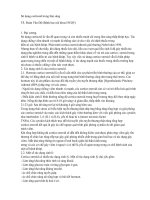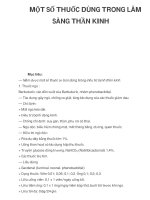123doc corticoid trong lâm sàn
Bạn đang xem bản rút gọn của tài liệu. Xem và tải ngay bản đầy đủ của tài liệu tại đây (14.13 MB, 56 trang )
SỬDỤNGCORTICOIDTRONG
VIÊMLOÉTGIÁCMẠCNHIỄMTRÙNG
TS.BS.Nguyễn Đình Ngân
HọcViệnQuânY
1
Nộidung
• Đạicươngvềcorticoid
• CorticoidtrongviêmloétGMNT
– Trongloétgiácmạcdovikhuẩn
– Trongviêmloétgiácmạcdovirus
– TrongviêmloétgiácmạcdoAncathamoeba
– Trongviêmloétgiácmạcdonấm
2
Glucocorticoid
• Hormonvỏthượngthận:
– Tácđộnglênnhiềuquátrìnhsinhlý
• Chuyển hóa Đường,Protein,Lipid
• Kiểm soát các chất điện giảI
• Đáp ứng miễn dịch
• Điều hòa viêm
• Kiểm soát hành vi
• Đáp ứng với Stress
3
Glucocorticoid
The
new england journal
CH2OH
• Chốngviêm
Cytokines
Bacteria
Viruses
Free radicals
Ultraviolet radiation
HO
C O
OH
O
Cortisol
IkB
IkB kinase
of
medicine
Repression by means of negative
glucocorticoid-responsive elements
Corticotropin-releasing hormone
Pro-opiomelanocortin
Cytokines
Osteocalcin
Cytokine receptors
Proliferin
Chemotactic proteins
Keratins
Adhesion molecules
Interleukin-1b
Collagenases
Matrix metalloproteinases
c-Jun
Fos
Glucocorticoid
receptor
NF-kB
MAPK
phosphatase I
Jun N-terminal
kinase
Cytokines
Growth factors
Mitogens
Bacteria
Viruses
Ultraviolet radiation
Annexin I
Cytokines
Cytokine receptors
Chemotactic proteins
Adhesion molecules
Cytokines
Hormones
Mitogens
Endotoxin
Antigen
MAPKs
Phospholipids
cPLA2a
COX-2
MAPK-interacting
kinase
Arachidonic acid
5-LOX
Calcium kinase II
Calcium/calmodulin–
dependent kinase II
Calcium
Minor pathways
Prostaglandins
Leukotrienes
Inflammation
Core pathways
Enzyme
Protein kinase
Inflammatory
transcription factor
Protein
phosphatase
Inhibitory protein
Figure 4. Partial Molecular Architecture Underlying the Glucocorticoid-Induced Antagonism of Inflammation.
Inflammatory pathways are characterized by positive feedback loops (i.e., cytokines activate NF-kB, which in turn stimulates the synthesis of more
4
Glucocorticoid
• Chốngviêm:mọinguyênnhân
– Ức chế́ huy động bạch cầu đến ổ viêm
– Giảm sản xuất và hoạt ~nh của nhiều chất TGHH của viêm: histamin,
serotonin, bradykinin...
– Giảm tổng hợp và sản xuất Leucotriens, Protaglandins
– Ức chế giải phóng các men tiêu thể, các gốc tự do à giảm hóa ứng
động, hoạt tính các men collagenases, plasminogen, elastase....
– Giảm hoạt động thực bào của Macrophage (đại thực bào), tế bào đa
nhân trung ~nh và giảm sản xuất các cytokin
– Tăng sức bền thành mạch, giảm thấm dịch vào khoang gian bào
5
Glucocorticoid
• Chốngviêm:mộtsốthuốcthườnggặp
Tên
T/dchống viêm
T/dgiữ muối
Hydrocortison
1
1
Prednisolon
4
0,8
Methylprednisolon
5
0,5
Triamcinolon
5
0,5
Betamethason
25-30
0
Dexamethason
25-30
0
6
Glucocorticoid
• ỨcchếMD:
– Trên tế bào:
• Gắn vào receptorở bào tương à phức hợp gắn AND
• Tác động lên AMPc à sinh trưởng TBLympho
– Trên quần thể tế bào:
• Huỷ TBLympho (đặc biệt TBtuyến ức)
• Giảm tập trung các TBviêm
– Trên đáp ứng miễn dịch:
• Ức chế phản ứng quá mẫn muộn
• Giảm Lympho Tgây độc
7
Glucocorticoid
• ỨcchếMD:
Đại thực bào
Kháng nguyên
giải phóng
(-)
Corticoid
Interleukin 1,6
giải phóng Lympho T
Interleukin 2 (-)
Cyclosporin A
Lympho T
Lympho T hoạt hoá
8
Glucocorticoid
• Tác dụng chống viêm GMcủa một số dạng thuốc tra thường gặp
Thuốc tra mắt
Tác dụng chống viêm
(giảm khi còn biểu mô GM)
Prednisolon Acetate 1%
51%
Dexamethasone 0.1%
40%
Fluorometholone 0.1%
31%
Prednisolone phosphate 1%
28%
Dexamethasone phosphate 0.1%
18%
9
Glucocorticoid
Nồng độ thuốc trong tiền phòng theo thời gian (ng/ml)
Dexamethason alcohol0,1%và Fluorometholone alcohol0,1%nhũ tương
Prednisoloneacetat 1%nhũ tương,Prenisolone phosphate 0,5%dungdịch
10
CorticoidtrongviêmloétGMNT
11
Nguyên nhân
• Nhiễm trùng
– Vikhuẩn
– Virus
– Nấm
– Ký sinh trùng
12
VLGMdoVK
• Bệnhsinh :
– (1):chết TBbiểu mô,
hoại tử nhu mô
– (2):kích hoạt hệ men
(2)
tiêu protein,hóa ứng
động BC
– Gây bệnh khi TBbiểu
(1)
mô bị tổn thương
hoặc chết
13
VLGMdoVK
• Vai trò của corticoidstrongđiềutrị
– Tác dụng
• Ức chế viêm và giảm phản ứng tạo sẹo (+)
• Ức chế tổng hợp collagen(-)
• Ức chế miễn dịch tại chỗ (-)
• Tăng nhãn áp (-)
• Kích thích nhiễm trùng tái phát (-)
– Lýthuyết:điềuchỉnh↓pháhuỷ,↑hàngắn
“Sử dụng corticoidhợp lý có thể làm giảm tổn thương GM”
Leibowitz H.M.etal,Arch Opthalmology 2002
14
VLGMdoVK
• Vai trò của corticoids
– Có giá trị trong loét GMdoPseudomonas
Leibowitz H.M.etal,ArchOpthalmology 2002
– Làm giảm thị lực trầm trọng hơn trong loét GMdoNocardia
Lalitha P.etal,AmJOphthalmol 2012
– Các nghiên cứu đối chứng ngẫu nhiên đến nay
• Chưa có bằng chứng về sự antoàn,hiệu quả của corticoid
Herretes S.etal,CochraneDatabaseSyst Rev 2014
15
VLGMdoVK
• Vai trò của corticoids
– Có giá trị trong loét GMdoPseudomonas
Leibowitz H.M.etal,ArchOpthalmology 2002
– Làm giảm thị lực trầm trọng hơn trong loét GMdoNocardia
Lalitha P.etal,AmJOphthalmol 2012
– Các nghiên cứu đối chứng ngẫu nhiên đến nay
• Chưa có bằng chứng về sự antoàn,hiệu quả của corticoid
Herretes S.etal,CochraneDatabaseSyst Rev 2014
16
1769 Assessed for eligibility
1269 Excluded
1219 Did not meet
inclusion criteria
50 Declined to
participate
Insurance Portability and Accountability Act, adhered to the
tenets of the Declaration of Helsinki, and was registered at
clinicaltrials.gov (NCT00324168).
VLGMdoVK
Enrollment
500 Randomized
Analysis
3-Month
Follow-up
3-Week
Follow-up
Allocation
• Vai trò của corticoids
250 Allocated to placebo
250 Received allocated
intervention
250 Allocated to corticosteroid
250 Received allocated
intervention
10 Lost to follow-up
11 Discontinued intervention
10 Lost to follow-up
2 Died
5 Discontinued intervention
18 Lost to follow-up
3 Died
19 Lost to follow-up
3 Died
220 Analyzed; 211 actual
and 9 LOCF
9 Excluded from analysis
(patient did not visit in
follow-up window)
222 Analyzed; 214 actual
and 8 LOCF
6 Excluded from analysis
(patient did not visit in
follow-up window)
Figure 1. Consolidated Standards for Reporting Trials flowchart.
LOCF indicates last observation carried forward.
this report, we present the primary outcome and the main
outcomes of the trial.
METHODS
INTERVENTION
Patients were randomized to receive topical prednisolone sodium phosphate, 1.0%, or placebo after a cornea culture that
tested positive for bacteria and after they had received 48 hours
of topical moxifloxacin. The prednisolone sodium phosphate
and placebo regimens consisted of 1 drop applied topically 4
times per day for 1 week after enrollment, then twice a day for
1 week, and then once a day for 1 week. The moxifloxacin treatment regimen for both arms consisted of 1 drop applied topically every hour while awake for the first 48 hours, then 1 drop
applied every 2 hours until reepithelialization, and then 4 times
a day until 3 weeks from enrollment. Treating physicians were
allowed to change or discontinue the use of any medications,
including the antibiotic and study medication, if they thought
it was medically necessary.
STUDY PARTICIPANTS
Eligible patients had a culture-positive bacterial ulcer and had
received at least 48 hours of topical moxifloxacin before randomization. Complete microbiological methods have been described previously.11 Major exclusion criteria included corneal
perforation or impending perforation, evidence of fungus on
potassium hydroxide preparation, Giemsa stain or culture, evidence of acanthamoeba by stain, evidence of herpetic keratitis
by history or examination, use of a topical corticosteroid or systemic prednisolone during the course of the present ulcer, previous penetrating keratoplasty, and vision less than 6/60 in the
fellow eye. Complete inclusion and exclusion criteria have been
described previously.11 Enrollment centers included
the Ara17
vind Eye Care System (Madurai, Coimbatore, and Tirunelveli,
Điều trị
- Dùng corticoidlợi:
• Vai trò của corticoids
+Nhóm thị lực thấp (ĐNT):TLtăng 1,7hàng
+Loét trung tâm (trong ĐK4mm):tăng TL≈2
hàng
+Thời gian dùng:dùng sớm 2- 3ngày tăng thị
lực tốt hơn
+Nhóm loét doTKMXít thâm nhiễm:TLtăng
2,5hàng
- Dùng corticoidhại:Nocardia
+Sẹo rộng hơn
+Thị lực sau 1năm kém hơn
18
Điều trị
• Vai trò của corticoids
Nếu sử dụng cần chú ý
– Xác đinh được nguyên nhân (loại trừ nấm,Nocardia)
– Sau khi sử dụng KSlàm tổn thương tốt lên
– Sử dụng liều tối thiểu có thể
– Điều chỉnh liều theo tổn thương
– Theodõi sát
– Đánh giá nhãn áp thường xuyên
19
VLGMdovirus
• ViêmgiácmạcdoAdenovirus
• ViêmgiácmạcdoHerpes
– Viêmbiểumô
– Viêmnhumô
– Viêmnộimô
20
VLGMdovirus:Adenovirus
• Chia 2giai đoạn
– Giai đoạn cấp:
• TCrầm rộ,trong 2tuần đầu
• Có sự nhân lên của virus
– Giai đoạn mạn
• Sau 2tuần
• Biểu hiện chủ yếu trên giác mạc
• Kết quả của phản ứng miễn dịch
• Mô học:thâm nhiễm dưới biểu mô của tế bào lympho,
nguyên bào sợi ,vỡ các sợi collagencủa màng Bowman
Thể lâm sàng viêm KGMAdenovirus
• EKC:thể viêm KGMnặng nhất
– Tổn thương trên giác mạc
• Giai đoạn 1:ngày thứ 2- 5
Rộp biểu mô 25– 30µm
Sau bongbiểu mô tạo nên chấm nông
Tổn thương dovirussống
Thể lâm sàng viêm KGMAdenovirus
• EKC:thể viêm KGMnặng nhất
– Tổn thương trên giác mạc
• Giai đoạn 2:từ ngày 5- 10
Các tổn thương nhập vào với nhau
Tạo các đám biểu mô chấm trắng,giữa bắt màu fluorescein
Có thể tạo sợi biểu mô
Tổn thương dovirussống
Chiếm 13– 70%EKC(haygặp dophân nhóm 8H)
Thể lâm sàng viêm KGMAdenovirus
• EKC:thểviêmKGMnặngnhất
– Tổnthươngtrêngiácmạc
• Giaiđoạn3:từtuầnthứ2
Xuấthiệncácđámthâmnhiễm
dướibiểumô
Viêmchấmgiảmdần
ViêmKMgiảmdần
QuátrìnhnhânlêncủavirusdừngdođápứngMDcủavậtchủ
Thể lâm sàng viêm KGMAdenovirus
• EKC:thểviêmKGMnặngnhất
– Tổnthươngtrêngiácmạc
• Giaiđoạn4:từtuầnthứ3
Khôngbắtmàufluor
Tổnthươngđốmthườngở
trungtâm
Thịlựckhônggiảmnhiềunhưngbệnhnhânlóa,nhìnquầng
Tồntạinhiềutháng









